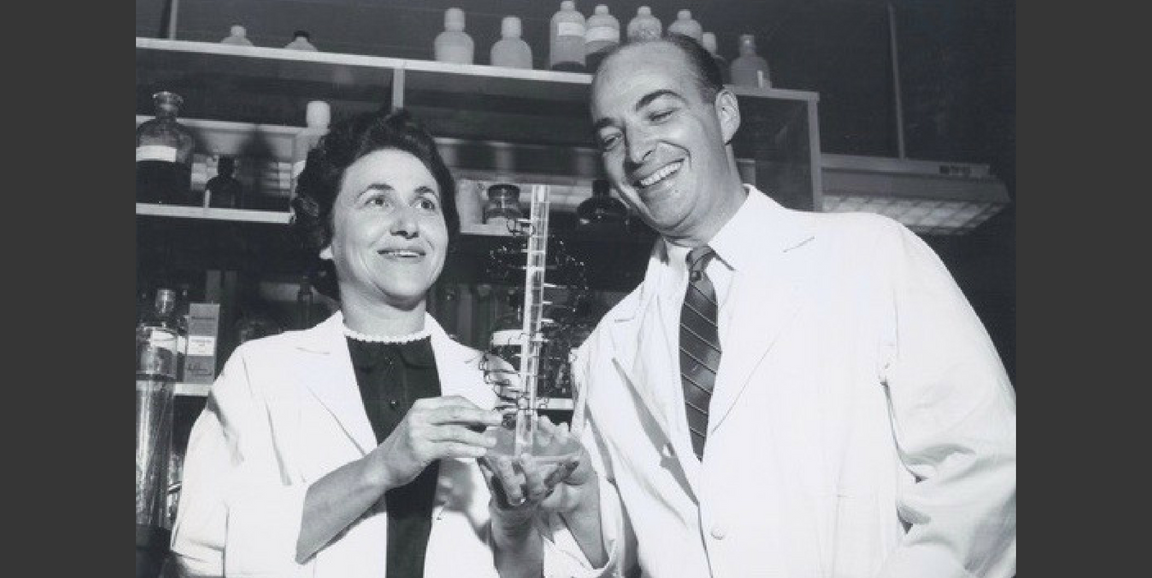This is the story of my grandmother Sylvy. As with so many other female scientists of her generation, you probably haven’t heard her story.
Sylvy Ruth Levy was born in 1917 in Rochester, New York, the eldest of three children. Her parents were Jewish refugees from Latvia and Belarus with no formal education, who worked in factories their entire lives.
Sylvy earned bachelor’s and master’s degrees in biochemistry at the University of Rochester, where she was one of the few women to commute from the women’s campus to attend advanced biology and chemistry courses. Her first job after graduate school was at the National Cancer Institute, where she worked on the effects of carcinogens on mice.
She met my grandfather, Arthur Kornberg, in Rochester, and married him in 1943. Supposedly, on their first date, Arthur bragged to Sylvy that he had gotten a perfect score in chemistry on the New York State Regents Exam. He would later find out that Sylvy got perfect scores not only in chemistry, but also in geometry and algebra on the exams.
In 1947, my father Roger was born, followed by my two uncles, Tom (1948) and Ken (1950). In a 1959 interview with the Miami Herald, Sylvy said, “Who says a wife and mother can’t have a career outside the home? Sure, I stayed home when my boys were little but I kept a hand in the lab.” When her sons were small, Sylvy edited science books from home; she returned to the lab when her youngest son was 3.
Sylvy made scientific contributions alone and with Arthur. Sylvy and Arthur discovered the second example of the synthesis of a polymer by an enzyme, the synthesis of polyphosphate. Her work on polyphosphate was important for understanding how cells store energy and recover it for use. This work also provided a starting point for the enzymatic synthesis of DNA (an alternating polymer of sugar and phosphate). Sylvy was later the first author of a paper describing an enzyme that interferes with DNA synthesis and of a paper describing how a bacterial virus avoids destruction of all other DNA in an infected cell. These studies were among the first steps on the pathway to genetic engineering.
In 1959, my grandfather Arthur received the Nobel Prize in Physiology or Medicine for his discovery of DNA polymerase. Arthur wrote in his autobiography, “For the love of enzymes”, that Sylvy "contributed significantly to the science surrounding the discovery of DNA polymerase.” Its dedication reads: “in memory of Sylvy, my great discovery.”
Sylvy died of a neurodegenerative illness in 1986, at the age of 69.
Sylvy became a successful scientist despite the circumstances of her birth — at the time only 140,000 women in the U.S. graduated from college each year and very few scientists and engineers were women. She did not receive the credit, or have the opportunities in science, that were given to my grandfather. When asked by a reporter why she didn't share in the Nobel Prize, she responded, tongue in cheek, “I was robbed.”
Just recently, an article about cancer research featured a picture of my grandmother weighing a chemical in a lab. Only her male colleague, also pictured, was originally named in the article; she was called a “pharmacy technician,” rather than a fellow biochemist. (The Scientist went on to write a feature about Sylvy).
Clearly, we still have a long way to go to achieve gender parity. As of 2017, the Nobel Prize has been awarded to nearly 900 men and only 48 women. Women have received about 5 percent of Nobel Prizes in Physiology or Medicine. Today only 29 percent of the science and engineering workforce in total in the U.S. are women. I was lucky enough to be raised by one of those women, my mother, Yahli Lorch, PhD, Stanford associate professor of structural biology.
Though her sons — my father, Roger, won the Nobel Prize in Chemistry in 2006 — and husband have received much attention in the world of science, very little has been written about Sylvy. I hope that in telling her story I can honor her memory and those of the many other women who contributed to the advancement of science and whose stories have been left untold.
Photo of Sylvy and Arthur Kornberg courtesy of Maya Kornberg
Maya Kornberg is a PhD student in political science at Oxford University. Her research examines the effect of specialized outside information on the legislative process. She is a graduate of Stanford University (B.A. ’13).




